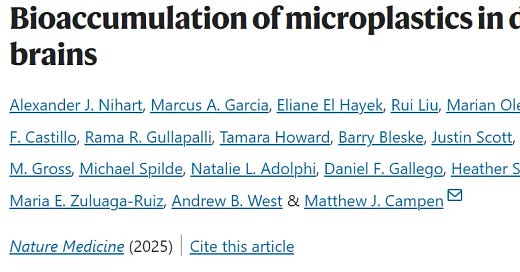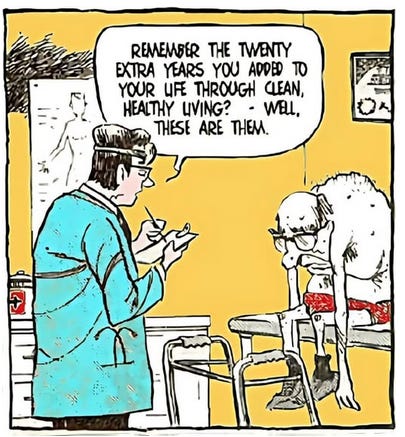Five days ago, Zerohedge.com reprinted an Epoch Times article about a new study that found worrying levels of microplastics in the autopsied brain tissue of 104 Americans in New Mexico.
I’ve been waiting to see if the mainstream media picks up on this story. It has managed to get some coverage in quite a range of mainstream outlets. That said, my strong sense is that it’s mostly getting one day of coverage on page 17; blink once and you’ll miss it.
I’m guessing the majority of people reading this will not have heard about the study, so let me quickly lay out its main findings.
The study was published in the journal Nature Medicine. Researchers from the University of New Mexico measured micro- and nano-plastic levels in 52 brain samples in 2016 and an additional 52 samples in 2024. The study found that: “Microplastics are making their way into human brains at higher levels than in other vital organs.” This was surprising to researchers in that the blood-brain barrier is usually fairly effective at keeping toxins out of the human brain. Instead, researchers found “Brain tissue contained 7 to 30 times more microplastics than other vital organs”
By 2024, the average brain studied contained 5000 micro-grams of plastic for every gram of brain tissue. This means that the average human brain measured contained the equivalent of a plastic spoon in microscopic shards of various plastics.
The 2024 level of micro-plastics found in the brain samples was 50% higher than what the researchers had measured just eight years earlier.
Two other findings of the study should give cause for concern. One is that the level of microplastics was similar across all age groups: This is not something that’s only going to be a problem for old people. And the other is that the level of microplastics in the brains of those in the sample who died with dementia was much higher than the average.
The researchers found twelve different types of plastics in the analyzed brain tissue, with polyethylene by far the most common.
If I worked for the plastics industry, I could easily come up with several reasons to not become overly alarmed over this one study:
It’s a small sample size, which limits the accuracy of the findings.
Perhaps the New Mexico area has way higher levels of microplastics than anywhere else in the North America.
Perhaps there was a methodological error of some kind that caused these researchers to seriously over-estimate the levels of micro-plastics found in brain tissues.
Perhaps the fact that older people showed no higher level of brain plastics than young people means the brain has some way of cleaning itself of microplastics which limits how much they bio-accumulate over time.
Perhaps dementia destroys the brains ability to keep microplastics out; perhaps higher levels of micro-plastics in those with dementia is a result of dementia rather than a cause of it.
Just because the level of micro-plastics has increased by 50 percent in a mere eight years, does not mean it will continue to grow at the same rate; perhaps it has already plateaued.
If all the above factors break the right way, perhaps my 17-year-old son could still enjoy a ripe old age in possession of all his marbles.
Unfortunately, it is equally possible for some or all of the numbers to break the opposite way:
Perhaps people in New Mexico happen to have markedly lower rates of brain micro-plastic than many parts of North America.
Perhaps a methodological error resulted in an under-counting of the microplastic shards.
Perhaps the fact that older brains do not have more micro-plastics than younger brains means the problem of micro-plastics in the environment is growing quickly and exponentially. Perhaps the level of micro-plastics in our air, water and food will grow even more rapidly once long-discarded plastics reach a certain age.
Perhaps micro-plastics in the brain do cause dementia, and we’ve only seen the front end of the huge increase that’s coming.
If ALL the above numbers happen to break the wrong way, my 17-year-old son could find his brain failing before he turns 30. (Is it unseemly to point out, in the worst case scenario that you and I might face the same fate a decade from now?)
It is important to not make too much of the results of a single study that examined only one hundred dead people’s brains. That said, this study has to has to be seen as a bright red flashing light.
We need way more information than we have right now, and we need it as soon as possible.
If Health Canada, the FDA and the CDC were to break themselves free from the clutches of the plastics industry, we could get at least partial answers in a matter of a few months:
Are the levels of brain micro-plastics found in this study confirmed in follow-on studies with larger sample sizes taken from all parts of North America?
What proportion of those suffering from dementia have elevated levels of plastics in the the brain? How could studies be designed to determine whether this was a cause or effect of dementia?
Are levels of micro-plastics in the brain still rising?
If further research indicates the New Mexico study is even ball-park close to reality, it’s a huge wake-up call, particularly if it can be determined that dementia is the result of high levels of micro-plastics and not its cause.
That outcome would leave us with several important tasks:
It would become very important to figure out how plastics are entering the human body. How much is in the air? How much is in the water? How much comes from house dust? How much comes from our food? What kinds of food? What steps could individuals take to significantly reduce the amount of microplastics they ingest?
It would also be important to determine if plastic food containers and plastic water bottles are a significant part of the the problem, or is it mostly caused by decades-old discarded plastics breaking down in the environment. Are some plastics more harmful to the brain than others?
Does the brain have some capacity to cleanse itself of microplastics, and are there nutrients which help the brain to do that?
What would be involved in phasing out plastic containers of all kinds? (Current ‘recycling’ of plastics is wishful thinking, not reality)
If we’re lucky, this could all turn out to be a giant false alarm.
If not, the micro-plastics in our brains could one day make the whole COVID pandemic seem like the minorest of inconveniences.
Courtesy of my friend Steve:
PS: In some ways the microplastics themselves are just the tip of the iceberg. The chemicals embedded in the plastics also come with a slew of issues, some of which are talked about here: https://www.aamc.org/news/microplastics-are-inside-us-all-what-does-mean-our-health
And the dangers of plastics do not stop with the brain:
https://www.theguardian.com/us-news/2025/feb/12/plastic-food-containers-heart-failure







Thanks for writing this up. This is an important story and it should be getting more traction! Funny, I had just purchased two stainless steel reusable covered coffee mugs (for tea) because one of the mugs we had was plastic and it is old enough it's probably not BPA-free either.